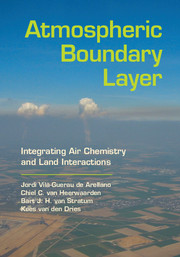Book contents
- Frontmatter
- Contents
- CLASS Software
- Preface
- Acknowledgments
- Part I The Land-Atmospheric Boundary Layer System
- Part II The Uncoupled System
- Part III The Coupled System
- 9 Atmosphere-Vegetation-Soil Interaction
- 10 Numerical Experiments: Atmosphere-Vegetation-Soil Interaction
- 11 A Dynamic Representation of Carbon Dioxide Exchange from the Vegetation and Soil
- 12 Sensitivity of the Atmosphere-Vegetation-Soil System to Climate Perturbations
- 13 Case Studies of More Complex Situations
- Part IV Processes Related to Boundary Layer Clouds
- Part V User's Guide: CLASS Modules and Variables
- Appendices
- Bibliography
- Index
11 - A Dynamic Representation of Carbon Dioxide Exchange from the Vegetation and Soil
from Part III - The Coupled System
Published online by Cambridge University Press: 05 July 2015
- Frontmatter
- Contents
- CLASS Software
- Preface
- Acknowledgments
- Part I The Land-Atmospheric Boundary Layer System
- Part II The Uncoupled System
- Part III The Coupled System
- 9 Atmosphere-Vegetation-Soil Interaction
- 10 Numerical Experiments: Atmosphere-Vegetation-Soil Interaction
- 11 A Dynamic Representation of Carbon Dioxide Exchange from the Vegetation and Soil
- 12 Sensitivity of the Atmosphere-Vegetation-Soil System to Climate Perturbations
- 13 Case Studies of More Complex Situations
- Part IV Processes Related to Boundary Layer Clouds
- Part V User's Guide: CLASS Modules and Variables
- Appendices
- Bibliography
- Index
Summary
The interaction between vegetation and atmospheric conditions opens up new possibilities for the study of the coupling of the soil, vegetation, and the atmosphere. Moreover, it enables us to understand how biological processes related to the vital functioning in the plant exert an influence on the diurnal variability of the thermodynamic variables. In previous chapters, we learned how modifications of the conditions of soil such as moisture availability or the transfer rate of heat and moisture determine the surface forcing and boundary layer properties. There the plants interacted with the atmospheric conditions but without explicit mechanistic representations of plant behaviour. In this chapter, we implement new representations that enable us to study the carbon cycle at daily scales including the interaction of photosynthesis and stomatal aperture to radiation, temperature, and water vapour. Note that, as shown in previous chapters, a modification of the water vapour flux at the surface strongly influences energy partition, and thus the heat and moisture budgets and the dynamic characteristics of the boundary layer.
As living organisms, plants need to produce carbohydrates to live and grow. This complex biological process is called photosynthesis and basically requires the presence of sunlight, water, and carbon dioxide to take place. The interaction of these compounds that produces carbohydrates is expressed chemically by the reaction
6CO2 + 6H2O + hv → C6H12O6 + 6O2
(11.1)
Under daylight conditions (represented by photon energy, hv), the necessary CO2 is assimilated through the plant stomata, which act as mouths through which the interchange of compounds with the atmosphere takes place. The regulation of opening and closing of the stomata is very complex and involves several aspects of plant physiology and environmental conditions. In our approach, we take the essential components of these processes to represent this exchange of CO2 and H2O between the plant and the atmosphere. Since water vapour and carbon dioxide are exchanged at the stomata, by obtaining the rate of change (conductance) of carbon dioxide, we can infer the rate for water vapour. The main processes and variables included in the model are outlined in Figure 11.1.
- Type
- Chapter
- Information
- Atmospheric Boundary LayerIntegrating Air Chemistry and Land Interactions, pp. 138 - 147Publisher: Cambridge University PressPrint publication year: 2015

